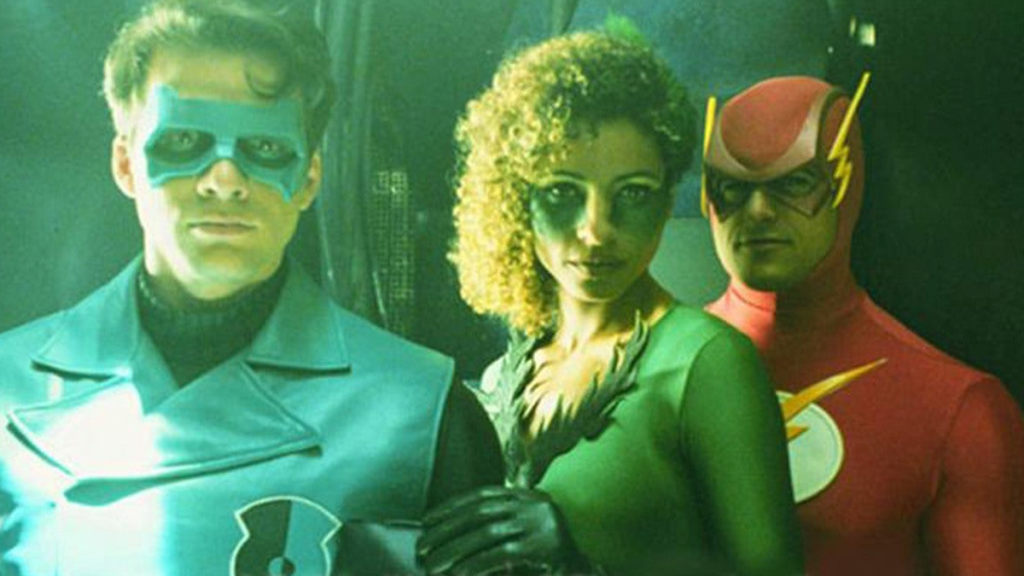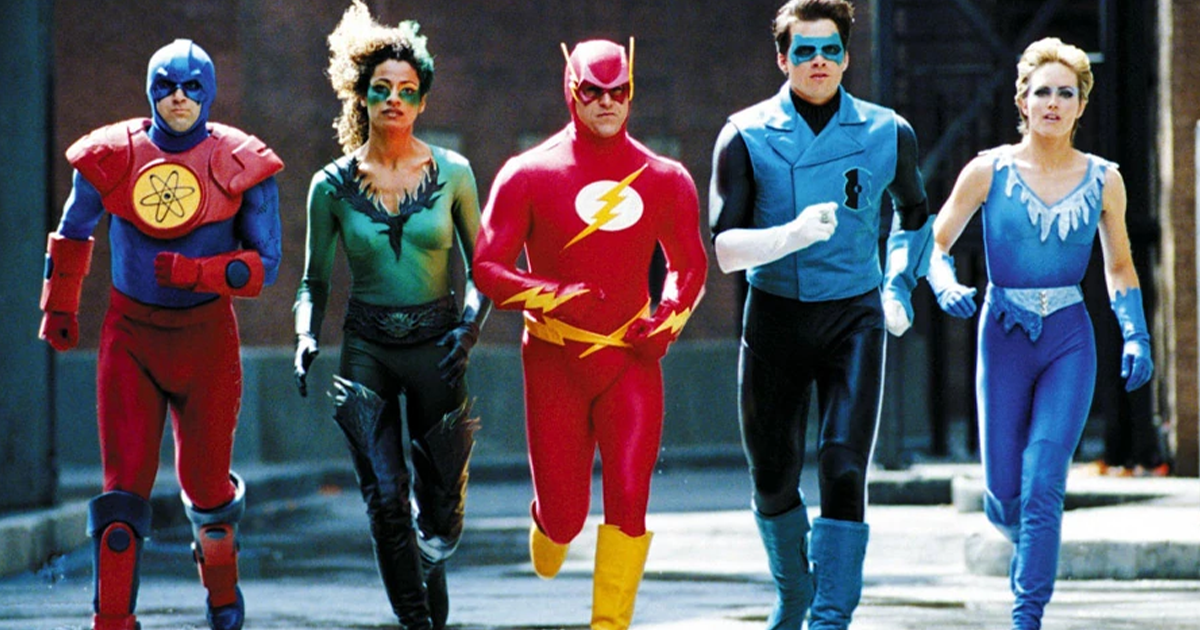With everything going on over at Warner Bros. in regards to the DC Universe, it might be nice to go back to a time when the team was (maybe) thriving, all of our favorites were (sort of) there, and things just seemed simple — in a way. Okay, so the 1997 Justice League of America movie isn’t what most would call “good” and is almost in the “so ’90s it’s unintentionally funny” category, but we’re here to talk about it 25 years later because this thing is an unrecognized piece of nerd history — no matter how harshly it got the original Batgirl treatment and was swept under the rug. This is less the humble beginnings of the Justice League and more the tragic adventures in an alternate reality — one of a made-for-television movie that never had a chance.
There’s no Batman, no Superman, and no Wonder Woman — those characters were tied up in projects the company thought might actually make it off the ground — and the classic trio couldn’t have helped this project anyway. Instead, viewers find themselves watching the heroes of New Metro City, which is like Metropolis, but obviously more low budget and Canadian. An interesting, but not unfathomable team that sees Green Lantern, Flash, The Atom, Fire, and a surprise leadership role for Martian Manhunter as the comic book heroes come to life off the page on a tiny budget.
Sounds like a solid lineup that should have been easy to work with, but there needs to be an audience introduction point. Enter Tora Olafsdotter: Ice (Kimberly Oja), who we see get her powers by accident, while the others are already active heroes. The origin stories that are explained seem a bit weak or have some laughable element to them. In fact, all of these characters come across as the more bland alternate versions from an extra laid-back world.

Here, several of the heroes live together and are barely getting by. Ray Palmer (John Kassir) is a high school teacher, not even a college professor, Beatriz Bonilla Da Costa (Michelle Hurd) is a struggling actress when she isn’t decked out in green, and the fastest man alive, Barry Allen (Kenny Johnston) is unemployed — even though he’s supposed to be a genius and can’t find anything other than working for the postal service. They wanted their own version of Joey from Friends, so he has to come across as more of a freeloading bum.
The real disgrace with this, however, is most likely Guy Gardner (Matthew Settle), who has been a police officer, a social worker, and a bar owner in the pages of the comics. To make sure he’s the most sterile version of a Green Lantern Corps member ever, in this world, he’s a software salesman who is more focused on his failing relationship than anything else.
None of them are particularly skilled at using their powers or do much impressive with them, even if there are a couple of noteworthy spots of attempts at heroism for when it was released. The action scenes are abrupt and almost whimsical. The Atom has an interesting-looking transformation into his shrunken self, but he uses it to rescue a cat under a house from some bad weather when it seemed perfectly safe there.
The inclusion of J’onn J’onzz (David Ogden Stiers) sees him in more of a background role, often in the shadows or in their underwater base, and many have pointed out that though he’s played by a fine actor, he physically doesn’t look the part. We do get to see his shapeshifting abilities when he briefly turns into the villain, Dr. Eno (Miguel Ferrer), who is poorly hidden as Tori’s boss, when he is actually The Weather Man — a watered-down version of Weather Wizard. He’s one of the best parts of the movie, so it’s easy to let that pass. It’s also humorous that Ferrer would go on to voice Weather Wizard in the Superman: The Animated Series cartoon, which was a definite upgrade.

To make sure no one is taking this movie too seriously, the tone is shaken from the first scene, which is a type of MTV’s Real World or mock-interview style segment. The characters are in their casual clothes and discussing their current superhero escapades in the past tense, letting us know they all survive. These segments have their real and superhero names, as well as showing them discussing their issues and relationships, or cutting up, so the big question is: who are these for? Maybe they’re only for the audience to know about, or it takes place years after the events of the movie, but either way, these interstitials don’t flow with the rest of the content and even when they stop being jarring, these bits still feel like they were added in later to fill out the runtime. For having subplots that show the individual team members trying to protect their secret identities, these recorded conversations are quite odd.
That sitcom-like approach is probably one of the best signs of how Justice League of America was a victim of bad timing. No one was taking superhero films seriously enough yet to give a television project like this a major budget and it shows, particularly in some of the visuals, the cheap costumes, and especially in the writing. The film had two directors: the first was Félix Enríquez Alcalá, a man experienced with the role but unable to make much of what was given to him, and that was before Lewis Teague was brought in to try and spruce up and improve the material. Teague said there simply wasn’t enough time or money available to make the necessary changes and asked to have his name removed from it — always a good sign.
It can be tough to find out information about how Justice League of America performed for CBS when it aired, because not everyone agrees on if it did make broadcast in the U.S. or not. We know that the movie was shown, as intended, in many international markets, and some believe that it was moved to air on December 28th of that year in America with no promotional build-up, taking a time slot that made it so most viewers would overlook the failure. However, there is a large group of people that claims the film was never shown here, or if it did, not nationwide as originally intended. Meaning many local affiliates wouldn’t have aired the programming at any time. Either way, this assures that very few people saw the film in 1997 and a decent copy in English wasn’t available online in full until 2015. This made the forgotten film hard to watch before then, outside of some international versions with English subtitles and bootleg copies sold at conventions. Even now, no one who owns the rights to it wants to acknowledge the masterpiece, as it has never been on any of the official DC streaming services and is mostly found on unaffiliated YouTube channels.
Had the television movie done well, it would have acted as a soft pilot for a Justice League ongoing series, similar to the much better but still problematic made for television film one year earlier from Marvel, Generation X. It’s hard to say that this needed a whole show, or if leaving this one instance of an early attempt at a Justice League movie alone was the best move, but many fans have been curious. Justice League of America’s 1997 movie isn’t particularly bad compared to many other projects that came out around that time, but it is close to crossing that line of “so bad in some ways that it’s good.” There are fun moments and almost enough time there for viewers to grow to like these awkward versions of the characters, but when Fire’s somewhat creepy love interest storyline is just as exciting as what’s going on with the main villain, that isn’t a great indicator. In the end, at least Justice League of American wasn’t DC Comics’ worst movie outing that year — they also gave us Batman and Robin six months earlier.
